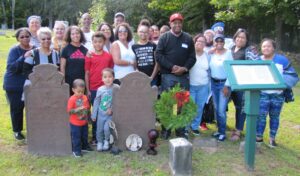Venture Smith Gravesite

Venture Smith: A Story of Resilience and Freedom
The cemetery next to the First Church in East Haddam, Connecticut, is the final resting place of Venture Smith (1728–1805) and several of his family members. Smith was captured as a child in Africa, enslaved in Connecticut, and later purchased his own freedom through years of labor and determination. His autobiographical narrative, first published in 1798, remains one of the most significant first-person accounts of early Black life in America.
A Journey from Enslavement to Independence
Born Broteer Furro in 1729, Venture Smith was the son of an African prince. As a child, he was kidnapped, marched to the West African coast, and sold into slavery. His first master purchased him for rum and calico cloth, renaming him Venture. After being sold multiple times, Smith eventually worked tirelessly to earn his freedom and later purchased the freedom of his wife and children.
Upon settling in Haddam Neck, he became a successful landowner, acquiring 134 acres, where he built three houses, a farm, a dry dock, a blacksmith shop, and other businesses. His memoir, included in Five Black Lives, provides rare and invaluable insight into the experiences of Black individuals in early America.
A Legacy of Service and Strength
Venture Smith’s wife is buried beside him, and nearby rests his son Solomon, who served in the War of 1812. Another son fought in the American Revolution, further cementing the family’s contributions to the nation. Smith’s granddaughter, who passed away in 1902, is also interred in the cemetery.
Their gravestones, located near the wall next to the church, stand as a powerful testament to resilience, perseverance, and the pursuit of freedom, ensuring that Venture Smith’s remarkable legacy endures.
This site is open to the public
Learn More
Sweet, John Wood. “Venture Smith, from Slavery to Freedom.” Connecticut History | a CTHumanities Project. Link.

